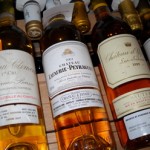 I recently attended a trade tasting for wine in new packaging. My husband was supposted to meet me at the event and I gave him the detailed address. However, when I arrived, I found a text message noting that he was here waiting for me outside. I found him in my line of sight standing against the door frame. It turns out that elevators must be operated by building staff at the hour – buttons could be pushed, but would not engage without a key. I had directed him to go to the Penthouse, but no button was labeled PH. Not surprisingly, he made the next best guess –12, since it was the top floor of the building. Yet, this was incorrect. The building staff finally recognized that the elevator guests were eager to get to the Artisanal Wine Tasting event, which was being held on 9 and helped us out.
I recently attended a trade tasting for wine in new packaging. My husband was supposted to meet me at the event and I gave him the detailed address. However, when I arrived, I found a text message noting that he was here waiting for me outside. I found him in my line of sight standing against the door frame. It turns out that elevators must be operated by building staff at the hour – buttons could be pushed, but would not engage without a key. I had directed him to go to the Penthouse, but no button was labeled PH. Not surprisingly, he made the next best guess –12, since it was the top floor of the building. Yet, this was incorrect. The building staff finally recognized that the elevator guests were eager to get to the Artisanal Wine Tasting event, which was being held on 9 and helped us out.
Once upstairs attendees were greeted warmly and invited to meet an Australian winemaker, Adam. We were then introduced to the Octavin –which we were not to call a box. They company was firm in that these were not boxed wines; they were casks.
The rented venue was more like a beautifully-furnished apartment than a party space and the guests found ourselves crowded around the kitchen table talking, eating and tasting, the way wine and food and supported to be enjoyed. The living room was comfortably furnished, but saw little of the action.
In the middle of all of this, a small subset of the Wine Media Guild began to arrive, which prompted a mini-scholarship meeting despite the absence of the committee chair. In truth, we were simply marveling at how much work Jonathan had already put together to bring to the group for discussion the next day. His thoroughness prompted some to wonder what else was left to do, but that question would be solved the next day in the proper channels.
Returning to the event at hand, participants tasted through the various white and red wines, while also having the opportunity to speak with Adam about his viticulture and vinification techniques and methods. It was very enlightening, especially in learning more about the unique, alternative packaging.
The Octavin is a stylish wine storage and service device that is much more elegant than the shape associated with the rectangular box. This isn’t your parents’ wine-in-a-box; they should have been so lucky. There are multiple wines produced under the Octavin line, but they have different names and hail from a variety of wine regions. It fits easily in the refrigerator and has its own open/close spout, which keeps the wine fresh for weeks. The cardboard construction significantly reduces that heft, thereby reducing the carbon footprint in both production and shipping — one cask is the equivalent of 4 bottles. We very impressed with the wines and enjoyed tasting them.
Reaching for a final appetizer toward the end of the tasting, I placed my glass of Cabernet Sauvignon on the edge of the kitchen counter while I reached over to grasp the onion bread. However, no sooner had I begun to reach for the food than the wine glass became unsteady and suddenly went down. It’s not clear if the glass itself was broken, but red wine flowed all over the hard-wood floors, down my arm and hand, and more embarrassingly, all over my husband’s blue, French-cuff shirt.
The cute gold paw print links were no match for the large ruby stains, which immediately began to soak in. A well-intentioned server brought him Wine Away, but with the volume of wine spilled, we decided that it was a job better suited for our valiant dry cleaners. In my own embarrassment, I grabbed at paper towels and, head bent, began to wipe the floor in an effort to prevent anyone from slipping on the wine. Fortunately, I had caught my husband in a good mood that he kindly excused my clumsiness and once dry (thanks to a towel provided by Adam), agreed to stay a little longer. Thus, with an eye toward the door, we re-tasted one or two of the red wines to finalize our impressions of them and then headed out into the night. Note to self: wear black next time.

